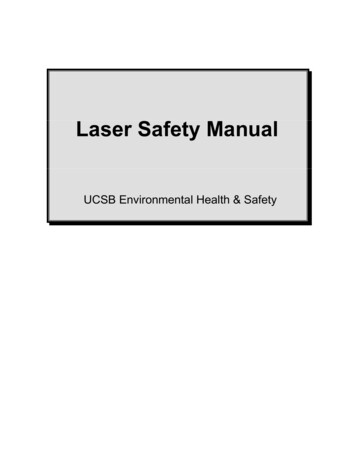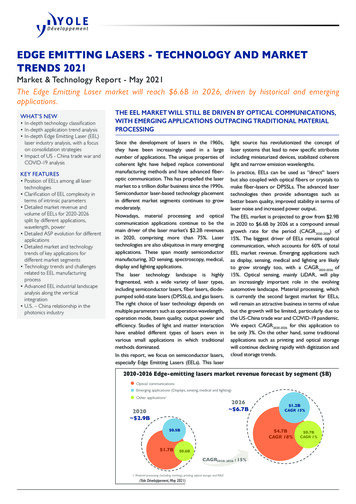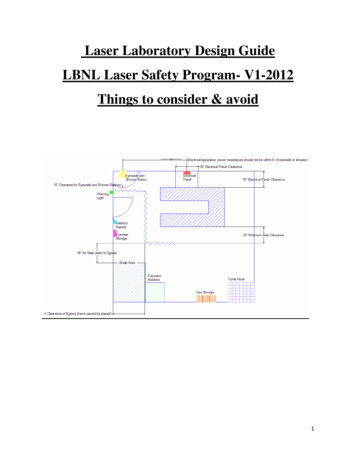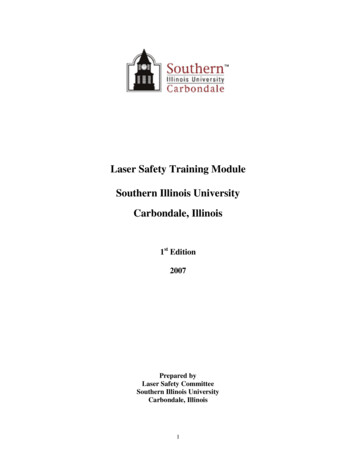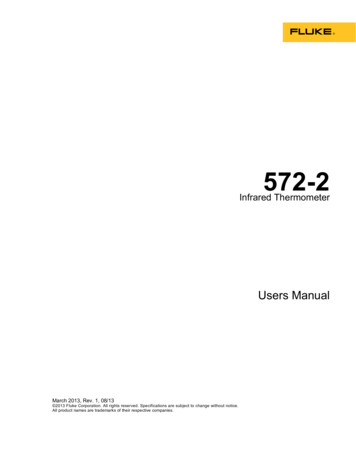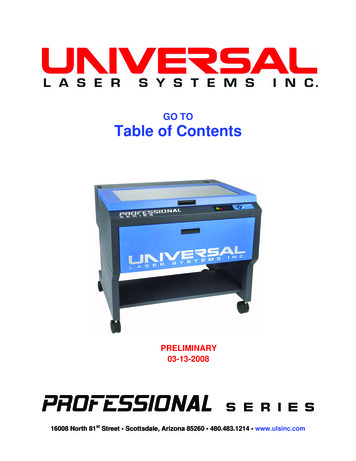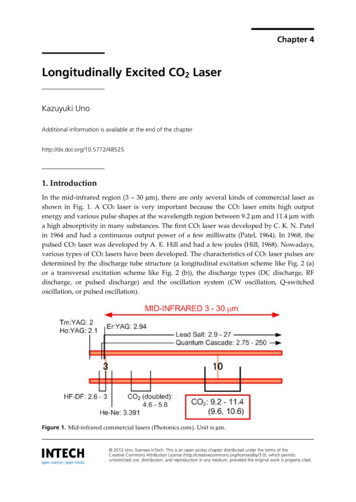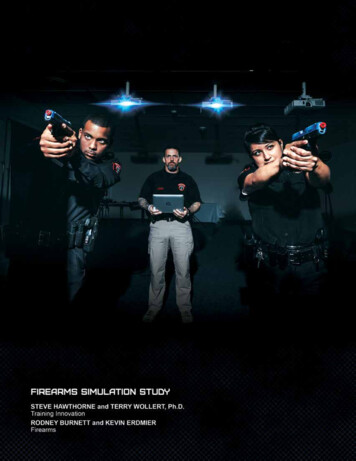
Transcription
Technology continues to transform how we live. Smartphones, laptops, and the networks that connect them enable us tocommunicate, work, and be entertained more quickly and efficiently with each passing year. The quickly growing and improvingfield of simulation technology is no exception. Simulators can be large in scale, like multi-million-dollar weapon system trainersutilized by military pilots, or as small as a common household gaming console.Since 2007, the Federal Law Enforcement Training Center (FLETC) has been using simulation technology to enhance studentlearning through the use of driving and marine simulators. More recently, the Avatar-Based Interview Simulator (ABIS) is beingstudied as a viable training tool for teaching students to conduct an interview using the five-step process they are taught inclass. Even the Firearms Division (FAD) uses laser handguns and branching videos to teach the Judgment Pistol ShootingCourse. Most recently, FLETC explored using simulation technology to teach basic marksmanship shooting skills by conductinga firearms simulation study.1FIREARMS SIMULATION STUDY
“.a major advantageover regular dryfire is that the LaserShot system providesimmediate feedback asto shot placement.”and can actually hinder training (Grant & Galanis, 2009). Thisis especially true when using a system which requires theweapon to be tethered to a canister that is attached to theshooters belt and supplies the carbon dioxide gas necessaryto simulate recoil. Untethered systems, which incorporatecarbon dioxide gas canisters into the magazine are available;but at this time, they are also cost prohibitive.AT FLETC a basic student’s first exposure to the use of handguns is inthe Basic Marksmanship Instruction (BMI) course. BMI includes basicweapons handling skills, including stance, grip, sight alignment, andtrigger control. So, in partnership with the FAD, the Training InnovationDivision (TID) began looking at various Firearms simulators for thestudy.Based on these findings, TID decided to first conduct researchusing a handgun without recoil. Specifically, TID, in concertwith FAD, decided to use a Glock 17 R with a resetting trigger.Each Glock was fitted with a laser insert that would fire aninvisible infrared laser each time the trigger was pressed.Therefore, the basics of stance, grip, sight alignment, andtrigger control would be similar to dry firing a real weapon.However, a major advantage over regular dry fire is that theLaser Shot system provides immediate feedback as to shotplacement.One such simulator is Laser Shot’s “FLETC Course of Fire.” As anenterprise supplier at FLETC, Laser Shot products are used by theFAD in the Judgment Pistol Shooting Course and by the Driver MarineDivision (DMD) in marine boat boarding training. Laser Shot’s “FLETCCourse of Fire” accurately simulates what a real range looks like,including targets that move, turn, and face for specific time intervals.In addition, Laser Shot’s “FLETC Course of Fire” can display practicallyany target while accurately simulating target size at various distances.Finally, the Laser Shot “FLETC Course of Fire” can easily be set up ina large classroom.Though basic students enrolled in the Criminal InvestigatorTraining Program (CITP) start out in BMI, their real goal isto shoot a qualifying score at the end of the SemiautomaticPistol Course (SPC). After attending BMI, students receive18 hours of SPC instruction. At the end, students shoot theFLETC SPC Course of Fire and must achieve a qualifyingscore of 210 out of 300 possible points. Therefore, thereal question to be answered is whether or not the finalqualifying SPC score of those using a laser handgun in BMIis significantly different from the final qualifying SPC scoreof those using a live-fire handgun in BMI.Next, the TID and FAD began looking at various styles of handguns.Essentially, there are two styles of handguns available; those withrecoil and those without recoil. Research by the U.S. Army indicatesthat recoil is not necessarily required to teach Basic Marksmanship(Smith & Hagman, 2000). Other research has found that though thetechnology of simulating recoil has advanced, it’s not always reliable,To answer this question, TID approached the College ofCoastal Georgia (CCGA) about allowing college studentsto participate in the Firearms Simulation Study. Onceapproved, TID staff and FAD instructors met with CCGAstudents majoring in Criminal Justice. As a result, 14 collegestudents initially volunteered to participate. Students wereLASER SHOT SIMULATIONS2
then stratified based on criteria including age, gender, and priorexperience with a handgun. The students were then randomlyassigned to one of two groups, those who would use a laserhandgun in BMI, and those who would use a live-fire handgunin BMI. All instruction was conducted in accordance with FADlessons plans and by FAD instructors. After completing BMI, allstudents participated in the FLETC SPC course of fire. Due to thetime constraints of the CCGA semester system, SPC instructionwas limited to only 14 hours rather than the normal 18 hours.After completing SPC instruction, students shot a finalqualification round. The average SPC qualifying score for thosecollege students who trained in BMI with a laser weapon was257.8. The average SPC qualifying score for those who trained inBMI with a live-fire weapon was 260.4. Average scores for eachgroup beginning with SPC-4 are shown in Chart 1, below. Thoughthere was only a 2.6 point difference, 14 participants were notenough to draw a conclusion about whether or not the differencewas statistically insignificant. However, the results were strongenough to suggest that the FAD and TID staff approach PartnerOrganizations about allowing their students to participate in thestudy. (To that end, the FAD and TID want to thank the UnitedStates Marshals Service (USMS) for volunteering three classesof their students enrolled in the Criminal Investigator TrainingProgram (CITP) to participate in the study.) This allowed for atotal of 140 students to be assigned to either BMI using a laserhandgun or to BMI using a live-fire weapon.As with the college students, the USMS CITP students werestratified into groups based on age, gender, and prior LawEnforcement or Military experience which included training onthe use of a handgun. The students were then randomly assignedto either train in BMI with a laser handgun or with a live-fire Glock22 .40 caliber handgun. Specific demographics for each groupare shown in Table 1, page 5.3FIREARMS SIMULATION STUDY
As with the college students, all instruction was conductedin accordance with FAD BMI and SPC lesson plans. RodBurnett and Kevin Erdmier served as the lead instructors withFAD staff providing all class and line instruction. Given thatthese were regularly scheduled training sessions, the full 18hours of SPC instruction was provided using the Glock 22.Those who used a laser weapon during BMI training shota SPC average qualifying score of 275.8. Those who useda live-fire weapon during BMI training shot a SPC averagequalifying score of 278.2. An independent t-test found thisdifference to be statistically insignificant. Average scoresfor each group during the last seven SPC sessions areshown in Chart 2, on page 5.To determine if the students in the research study performeddifferently than students who receive routine firearmstraining, data was compared to the three previous USMSCITP SPC classes. These USMS CITP classes were used asthe control group. In total, 138 students in prior classes whotrained with a live-fire handgun in BMI shot a SPC averagequalifying score of 275.8. This is the same average as thosewho trained with a laser handgun in BMI. Data analysisindicated that differences between the control group andthe study group were statistically insignificant. See Table 2on page 5 for a summary of SPC qualification scores.The students with prior military and/or law enforcementfirearms training who trained with a laser handgun in BMIshot an average SPC qualifying score of 280.1 comparedto an average SPC qualifying score of 282.5 for those whotrained with a live-fire handgun. These differences were alsostatistically insignificant. Those with no prior military and/or law enforcement firearms training who trained with alaser handgun in BMI shot an average SPC qualifying scoreof 265.0 compared to an average SPC qualifying score of266.8 for those who trained with a live-fire handgun in BMI. Again,these differences were statistically insignificant. These results arepresented in Table 3, page 6.Based on the score a student shoots, they are given one of fivepossible classifications. Scores below 210 are classified as “DidNot Qualify,” scores from 210 to 254 are classified as “Marksman,”scores from 255 to 284 are classified as “Sharp Shooter,” scoresfrom 285 to 299 are classified as “Expert,” and a score of 300 isclassified as “Distinguished Expert.” Results by category are shownin Table 4, page 6. Though there is some variation within eachclassification, based on the BMI training method, no statisticaldifferences were found. All students in the study group who “DidNot Qualify” were provided with four hours of live-fire handguntraining on BMI; subsequently, they shot a qualifying score duringthe reshoot.As mentioned before, all training was done in accordance with theapplicable lesson plans. However, those training with the laserhandguns during BMI did not need to wear hearing protection.This allowed instructors to carry on normal conversations whileinstructing students in the proper stance, grip, sight alignment,and trigger control. Students could freely ask questions and getanswers without having to “yell” or “read lips.” One instructorcommented that because he could get “up close and personal,” hewas able to see errors in weapon handling, especially in respect togrip and trigger press, that he would not have normally been able tosee. Other benefits include both a reduction in ammunition usage,accompanying cost savings associated with range maintenance,and in freeing up valuable range time. This additional range timecould then be used to teach more advanced live-fire courses and/or increase the through-put of basic training classes. Furthermore,since BMI using a laser handgun can be taught in a large classroom,those without an indoor range can still train no matter what theweather conditions might be outside.LASER SHOT SIMULATIONS4
If a laser handgun is to accurately simulatea live-fire handgun, the impact of recoil mustbe considered. As mentioned before, thereare recoil systems that incorporate carbondioxide gas cylinders into the magazine.When the trigger is pressed, gas is releasedcausing the slide to operate. This also forcesa student to reacquire their sights. Some ofthe more advanced simulated handgunscan even be programmed to simulate aweapon malfunction that can be cleared bythe “Primary Immediate Action” procedureand emergency reloads. However, even thebest simulated weapon with recoil cannotsimulate the concussion blast of a live-firehandgun. Still, future research should bedesigned to incorporate simulated recoil andshould seek to partner with other agenciesin order to evaluate the success rate with thefull range of FLETC students.In conclusion, it does appear thatthe CCGA students and the USMSCITP students training with anon- recoil laser handgun in BMIachieve statistically similar SPCqualification scores that studentstraining with a live-fire weaponachieve. In addition to the potentialcost savings, laser handgun BMItraining offers several instructionaladvantages and also providesa safer environment than livefire. In the end, nothing will everreplace actual live-fire or “puttingrounds down range.” However,several studies, to include theFLETC Live-Fire/Simulation Study,seem to indicate that firearmsimulation is a viable approachto certain introductory phases ofmarksmanship training and is onthe verge of becoming a valuabletool in both the teaching andlearning of psychomotor skills.300CCGA STUDENTS290BMI - LASER TRAINING280SPCBMI - LIVE-FIRE 210SPC - 4SPC - 4SPC - 4PRE QUAL.QUAL.SPC TRAINING SESSIONCHART 1FIREARMS PARTICIPATION STUDY DEMOGRAPHICSBMI TRAININGAVERAGEGROUP 1119NO PRIOR PRIOR EXPERIENCEEXPERIENCE (MILITARY OR LE)20195051TABLE 1SPC Qualification COURSESPC Qualification COURSEBMI TRAININGMETHODBMI TRAININGMETHODNO PRIOREXPERIENCEPRIOR EXPERIENCE(MILITARY OR UPUSMS CITPCONTROL GROUP275.8278.2N/A275.8LIVE-FIRETABLE 3TABLE 2BMI TRAINING METHOD 3 PRIOR CITPSPC CLASSIFICATIONDID NOT QUALIFYMARKSMANSHIPSHARP SHOOTEREXPERTDISTINGUISHED 0%7.1%47.1%37.1%8.6%0.7%10.9%50.8%35.5%2.2%TABLE 4- Smith, M., & Hagman, J. (2000). Predicting Rifle and Pistol Marksmanship performance with theLaser Marksmanship Training System (Tech. Rep. 1106). Alexandria, VA: U.S. Army Research Institutefor the Behavioral Sciences.FIREARMS SIMULATION STUDY260255253- Grant, S. C., & Galanis, G. (2009).Assessment and prediction of effectiveness of virtual environments: Lessons learned from smallarms simulation. In Cohn, J. & Nicholson, D. & Schmorrow, D. (Ed.) The PSI Handbook of Virtual Environments for Training and Education, Volume 3, Integrated systems, Training Evaluation, and FutureDirections, Westport, CT.5257
300USMS CITP STUDENTSBMI - LASER TRAINING290SPCSCORESBMI - LIVE-FIRE 270.1270.9273.0SPC - 7SPC - 8PRE QUAL.272.0278.2275.8261.4257.5SPC - 4SPC - 5SPC - 6QUAL.SPC TRAINING SESSIONCHART 2LASER SHOT SIMULATIONS6
S: (281) 240-1122
Laser Shot's "FLETC Course of Fire" accurately simulates what a real range looks like, including targets that move, turn, and face for specific time intervals. In addition, Laser Shot's "FLETC Course of Fire" can display practically any target while accurately simulating target size at various distances. Finally, the Laser Shot .
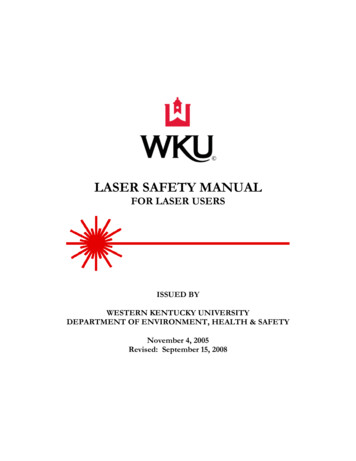
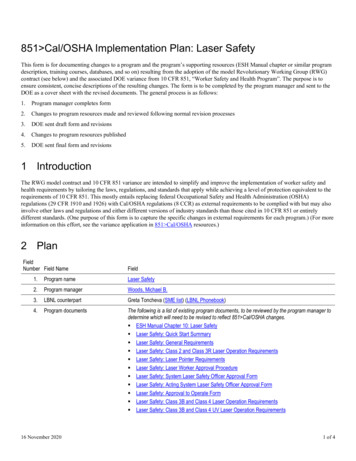
![firearms qualifications [PFP#730045656]](/img/59/firearms2003.jpg)

